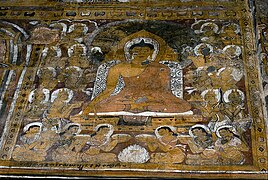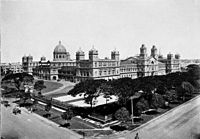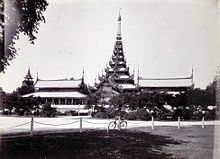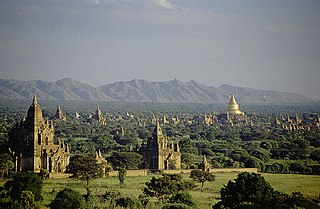
Bagan is an ancient city and a UNESCO World Heritage Site in the Mandalay Region of Myanmar. From the 9th to 13th centuries, the city was the capital of the Pagan Kingdom, the first kingdom that unified the regions that would later constitute Myanmar. During the kingdom's height between the 11th and 13th centuries, more than 10,000 Buddhist temples, pagodas and monasteries were constructed in the Bagan plains alone, of which the remains of over 2200 temples and pagodas survive.

Amarapura is a former capital of Myanmar, and now a township of Mandalay city. Amarapura is bounded by the Irrawaddy river in the west, Chanmyathazi Township in the north, and the ancient capital site of Ava (Inwa) in the south. It was the capital of Myanmar twice during the Konbaung period before finally being supplanted by Mandalay 11 kilometres (6.8 mi) north in 1859. It is historically referred to as Taungmyo in relation to Mandalay. Amarapura today is part of Mandalay, as a result of urban sprawl. The township is known today for its traditional silk and cotton weaving, and bronze casting. It is a popular tourist day-trip destination from Mandalay.

The Shwedagon Pagoda ; Mon: ကျာ်ဒဂုၚ်; officially named Shwedagon Zedi Daw and also known as the Great Dagon Pagoda and the Golden Pagoda is a gilded stupa located in Yangon, Myanmar.

The Pyu city-states were a group of city-states that existed from about the 2nd century BCE to the mid-11th century in present-day Upper Myanmar (Burma). The city-states were founded as part of the southward migration by the Tibeto-Burman-speaking Pyu people, the earliest inhabitants of Burma of whom records are extant. The thousand-year period, often referred to as the Pyu millennium, linked the Bronze Age to the beginning of the classical states period when the Pagan Kingdom emerged in the late 9th century.

Burmese pagodas are stupas that typically house Buddhist relics, including relics associated with Buddha. Pagodas feature prominently in Myanmar's landscape, earning the country the moniker "land of pagodas." According to 2016 statistics compiled by the State Sangha Maha Nayaka Committee, Myanmar is home to 1,479 pagodas exceeding 27 feet (8.2 m) in height, a quarter of which are located in Sagaing Region. Several cities in the country, including Mandalay and Bagan, are known for their abundance of pagodas. Pagodas are the site of seasonal pagoda festivals.

Bupaya Pagoda is a notable Buddhist pagoda located in Bagan, in Myanmar, at a bend on the right bank of the Ayeyarwady River. The small pagoda, which has a bulbous shaped dome, is widely believed to have been built by the third King of Pagan, Pyusawhti who ruled from 168 to 243 AD. It is one of the most notable shrines among the thousands of new or ruined Pagodas in Pagan, which is located about 90 miles (140 km) south of Mandalay.

The Thatbyinnyu Temple is a Theravadin Buddhist temple in Bagan (Pagan), Myanmar. The temple is recognized as a monument in the Bagan Archeological Area, a UNESCO World Heritage Site. Completed in 1150–51 during the reign of King Sithu I, the temple reflected the Bagan period's "innovative architectural and artistic creativity" and "an expression of the self-confident Burmese spirit of nationhood." At the pinnacle height of 66 m (217 ft), the five-story Thatbyinnyu is known as the tallest temple in Bagan, alongside the tallest stupa in Bagan, the 100 m (328 ft) Shwesandaw.
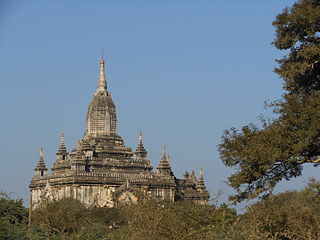
The Shwegugyi Temple is a Theravadin Buddhist temple in Bagan, Myanmar. The temple is recognized as Monument #1589 in the Bagan Archeological Area, a UNESCO World Heritage Site.

The Gawdawpalin Temple is a Buddhist temple located in Bagan, Myanmar. Construction of the pagoda began in 1203 during the reign of Sithu II (1174–1211) and completed on 26 March 1227 during the reign of Htilominlo (1211–1235). At 55 m (180 ft), Gawdawpalin Temple is the second tallest temple in Bagan. Similar in layout to the Thatbyinnyu Temple, the temple is two storeys tall, and contains three lower terraces and four upper terraces. The temple was heavily damaged during the 1975 earthquake and was reconstructed in following years.

Mingalazedi Pagoda is a Buddhist stupa located in Bagan, Burma. Construction started in 1274 during the reign of King Narathihapate. The pagoda is one of few temples in Bagan with a full set of glazed terra cotta tiles depicting the Jataka. The pagoda was built in brick and contains several terraces leading to large pot-shaped stupa at its centre, topped by a bejewelled umbrella (hti). Mingalazedi Pagoda was built a few years before the First Burmese Empire was pillaged by the Mongols.
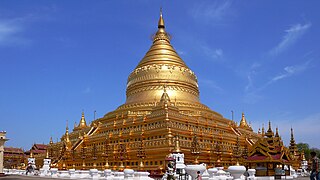
The Shwezigon Pagoda or Shwezigon Paya is a Buddhist stupa located in Nyaung-U, Myanmar. A prototype of Burmese stupas, it consists of a circular gold leaf-gilded stupa surrounded by smaller temples and shrines. Construction of the Shwezigon Pagoda began during the reign of King Anawrahta, the founder of the Pagan Empire, in 1059–1060 and was completed in 1102, during the reign of his son King Kyansittha. Over the centuries the pagoda had been damaged by many earthquakes and other natural calamities, and has been refurbished several times. In recent renovations it has been covered by more than 30,000 copper plates. However, the lowest level terraces have remained as they were.

The Kingdom of Pagan was the first Burmese kingdom to unify the regions that would later constitute modern-day Myanmar. Pagan's 250-year rule over the Irrawaddy valley and its periphery laid the foundation for the ascent of Burmese language and culture, the spread of Bamar ethnicity in Upper Myanmar, and the growth of Theravada Buddhism in Myanmar and in mainland Southeast Asia.

A kyaung is a monastery (vihara), comprising the domestic quarters and workplaces of Buddhist monks. Burmese kyaungs are sometimes also occupied by novice monks (samanera), lay attendants (kappiya), nuns (thilashin), and white-robed acolytes.

Narapati Sithu was king of Pagan dynasty of Burma (Myanmar) from 1174 to 1211. He is considered the last important king of Pagan. His peaceful and prosperous reign gave rise to Burmese culture which finally emerged from the shadows of Mon and Pyu cultures. The Burman leadership of the kingdom was now unquestioned. The Pagan Empire reached its peak during his reign, and would decline gradually after his death.

Pyatthat is the name of a multistaged roof, with an odd number of tiers. The pyatthat is commonly incorporated into Burmese Buddhist and royal architecture and towers above the image of the Buddha or other sacred places.

Sri Ksetra, located along the Irrawaddy River at present-day Hmawza, was once a prominent Pyu settlement. The Pyu occupied several sites across Upper Myanmar, with Sri Ksetra recorded as the largest, the city wall enclosing an area of 1,477 hectares, although a recent survey found it enclosed 1,857 hectares within its monumental brick walls, with an extramural area of a similar size, being the largest Southeast Asian city before Angkor times. Issues surrounding the dating of this site has meant the majority of material is dated between the seventh and ninth centuries AD, however recent scholarship suggests Pyu culture at Sri Ksetra was active centuries before this.

Kyauktawgyi Pagoda is a Buddhist pagoda located in Amarapura, Burma, near the Taungthaman Lake. It was built in 1847 by King Pagan Min on the model of the Ananda Pagoda at Pagan.

Art of Myanmar refers to visual art created in Myanmar (Burma). Ancient Burmese art was influenced by India and China, and was often religious in nature, ranging from Hindu sculptures in the Thaton Kingdom to Theravada Buddhist images in the Sri Ksetra Kingdom. The Bagan period saw significant developments in many art forms from wall paintings and sculptures to stucco and wood carving. After a dearth of surviving art between the 14th and 16th century, artists created paintings and sculptures that reflect the Burmese culture. Burmese artists have been subjected to government interference and censorship, hindering the development of art in Myanmar. Burmese art reflects the central Buddhist elements including the mudra, Jataka tales, the pagoda, and Bodhisattva.
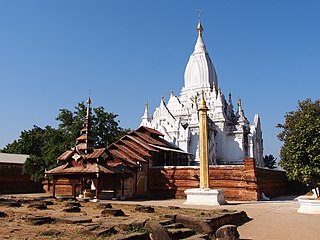
Lemyethna Temple, also known as Lemyethna Pagoda or the Temple of the Four Faces, is 13th-century Buddhist temple in Bagan, Myanmar. Built in 1222 by the Pagan Empire, the temple remains in regular use.









